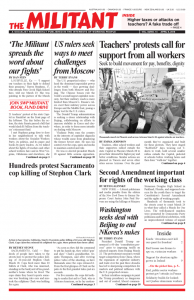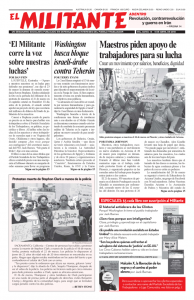Teachers, other school workers and their supporters rallied outside the state Capitol in Phoenix March 28 to press their demand for higher pay and better conditions. Similar actions are planned in Tucson and seven other cities across Arizona. Over the past month they’ve organized and built for these protests. They have staged “RedForEd” days wearing red T-shirts to work, held several smaller rallies outside the Capitol, picketed at schools before working hours and then done “walk-ins” together.
On March 21, teachers in the Pendergast Elementary District near Glendale called in sick, closing nine out of the district’s 12 schools. Many of the 350 teachers who didn’t show up for work were among the hundreds in red protesting at the Capitol that day.
Hundreds of teachers in the Chandler Unified School District wore their red shirts and marched together to the district’s annual staff assembly March 26. Seeking to emphasize teachers’ demands for higher pay — theirs is among the lowest in the country — Alex Kimble held up a piece of paper saying, “Can’t afford a sign.”
Katie Nash, a biology teacher at Chandler High, was one of the organizers. In addition to low pay, she said teachers face huge class sizes, pipes leaking lead and playgrounds falling apart.
The March 28 rally was organized through Arizona Educators United, a Facebook group with 36,000 members. Save Our Schools Arizona and the Arizona State PTA joined the action.
Educators United leader Noah Karvelis, who set up the Facebook page, told a March 26 press conference that the group’s full demands would be announced at the rally two days later, but would focus on raising wages. Karvelis said a walkout is not on the agenda, but that it may come to that, depending on how the legislature treats their demands.
The actions of teachers in Arizona are similar to those being carried out by school workers in Kentucky, Oklahoma and a number of other school districts. Many of the features of these mobilizations in Arizona were inspired by the successful nine-day school strike in West Virginia. Union members there built a powerful social movement, drawing in other unionists, students and parents and community organizations that helped provide places for students to go during the strike and food for the youth who get their meals at school. This laid the basis for forcing the state legislature to meet their demands. While teachers in other areas seek to follow their example, and they’re getting a response, nowhere else has the movement reached the same breadth.
Some 1,400 members of the Communications Workers of America went on strike against Frontier Communications in West Virginia and Virginia March 4, taking on bosses’ moves to eliminate jobs and force speedup on those who remain.
Backed by the United Mine Workers union, hundreds of workers and their supporters rallied March 24 in front of Frontier’s office in Charleston, West Virginia. Many workers said they hoped to win solidarity like the teachers had. The president of the state local of the American Federation of Teachers spoke, urging the workers to stand united. UMW President Cecil Roberts brought solidarity.
The next day the CWA announced the company had dropped its demand to cut more jobs and signed an agreement. Workers will go back to work March 28 and vote on the contract after having a chance to review it.
Oklahoma, Kentucky mobilizations
The Oklahoma Education Association, the biggest union for state school workers, has set an April 1 deadline for the state legislature to meet its demands or schools will shut the next day, when the union has called for a mass rally outside the state Capitol in Oklahoma City.
Many school boards have authorized their superintendents to close schools in the event of a strike and some boards have passed resolutions in support of a teachers’ walkout.
Union officials, however, have launched a proposal of tax increases that will hit other workers to fund education and raises for teachers. This will undercut the basis for solidarity. (See article this page.)
Workers and farmers in Oklahoma have been deeply affected by the crisis of capitalist production and trade today. More than 60 percent of the students are eligible for free or reduced-price breakfast and lunch at school. This is similar to West Virginia. During the strike there union members organized volunteers daily, including a lot of students, to collect, pack and distribute meals. The unions also organized transportation to churches and community centers for students so their parents wouldn’t miss work.
In Oklahoma, places for students to stay and get fed are being organized by school district officials, not by the unions drawing volunteers into the strike.
In Kentucky, school workers’ protests center on proposed cuts to pensions. Future teachers would get a 401(k)-type account instead of a regular pension, and cost-of-living allowances for retired teachers would be cut.
In a radio interview, Kentucky Gov. Matt Bevin called the teachers “selfish,” ignorant,” “shortsighted” and “thugs” for protesting the bill.
Teachers across the state held pickets and “walk-ins” March 19. Nearly 60 teachers, students and supporters rallied outside Atherton High in Louisville. Many wore red as a show of unity. Heather Waters, who works in the school library, held a sign appreciated by all — “Bevin, don’t make us go W[est] V[irginia] on you!”
Two days later hundreds of school workers rallied outside the Capitol in Frankfort as five eastern Kentucky school districts closed schools down. Teachers from different districts take turns in holding regular protests there, one on March 27, another March 29.


